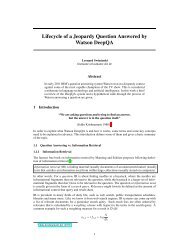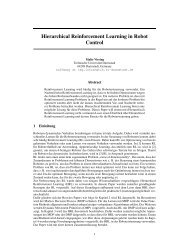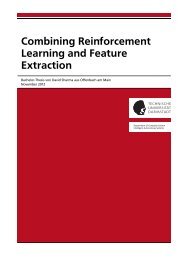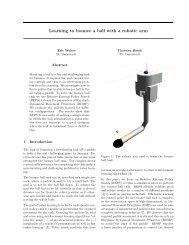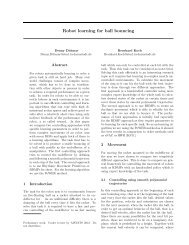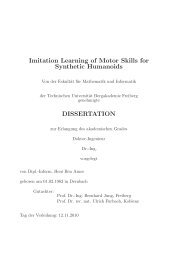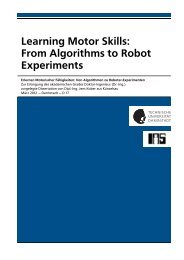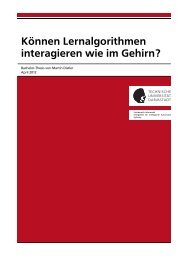Generalization of Human Grasping for Multi-Fingered Robot Hands
Generalization of Human Grasping for Multi-Fingered Robot Hands
Generalization of Human Grasping for Multi-Fingered Robot Hands
Create successful ePaper yourself
Turn your PDF publications into a flip-book with our unique Google optimized e-Paper software.
<strong>Generalization</strong> <strong>of</strong> <strong>Human</strong> <strong>Grasping</strong> <strong>for</strong> <strong>Multi</strong>-<strong>Fingered</strong> <strong>Robot</strong> <strong>Hands</strong>Heni Ben Amor, Oliver Kroemer, Ulrich Hillenbrand, Gerhard Neumann, and Jan PetersAbstract— <strong>Multi</strong>-fingered robot grasping is a challengingproblem that is difficult to tackle using hand-coded programs.In this paper we present an imitation learning approach <strong>for</strong>learning and generalizing grasping skills based on humandemonstrations. To this end, we split the task <strong>of</strong> synthesizinga grasping motion into three parts: (1) learning efficient grasprepresentations from human demonstrations, (2) warping contactpoints onto new objects, and (3) optimizing and executingthe reach-and-grasp movements. We learn low-dimensionallatent grasp spaces <strong>for</strong> different grasp types, which <strong>for</strong>m thebasis <strong>for</strong> a novel extension to dynamic motor primitives. Theselatent-space dynamic motor primitives are used to synthesizeentire reach-and-grasp movements. We evaluated our methodon a real humanoid robot. The results <strong>of</strong> the experimentdemonstrate the robustness and versatility <strong>of</strong> our approach.I. INTRODUCTIONThe ability to grasp is a fundamental motor skill <strong>for</strong>humans and a prerequisite <strong>for</strong> per<strong>for</strong>ming a wide range <strong>of</strong>object manipulations. There<strong>for</strong>e, grasping is also a fundamentalrequirement <strong>for</strong> robot assistants, if they are to per<strong>for</strong>mmeaningful tasks in human environments. Although therehave been many advances in robot grasping, determininghow to per<strong>for</strong>m grasps on novel objects using multi-fingeredhands still remains an open and challenging problem.Alot<strong>of</strong>researchhasbeenconductedonrobotgripperswith few degrees <strong>of</strong> freedom (DoF) which may not beparticularly versatile. However, the number <strong>of</strong> robot handsdeveloped with multiple fingers has been steadily increasingin recent years. This progress comes at the cost <strong>of</strong>amuchhigherdimensionality<strong>of</strong>thecontrolproblemand,there<strong>for</strong>e, more challenges <strong>for</strong> movement generation. Hardcoded grasping strategies will typically result in unreliablerobot controllers that can not sufficiently adapt to changesin the environment, such as the object’s shape or pose.Such hard coded strategies will also <strong>of</strong>ten lead to unnatural‘robotic looking’ grasps, that do not account <strong>for</strong> the increasedsophistication <strong>of</strong> the hardware. Alternative approaches, suchas the optimization <strong>of</strong> grasps using stochastic optimizationtechniques, are computationally expensive and require thespecification <strong>of</strong> a grasp quality metric [27]. Defining anadequate grasp metric is <strong>of</strong>ten hard to do, as it requires specifyingintuitive concepts in a mathematical <strong>for</strong>m. Additionally,such approaches typically do not consider the whole reachand-graspmovement but exclusively concentrate on the handHeni Ben Amor, Oliver Kroemer, Gerhard Neumann and Jan Petersare with the Technische Universitaet Darmstadt, Intelligent AutonomousSystems, Darmstadt, Germany. {amor, kroemer, neumann,peters}@ias.tu-darmstadt.deUlrich Hillenbrand is with the German Aerospace Center - DLR,Institute <strong>of</strong> <strong>Robot</strong>ics and Mechatronics, Oberpfaffenh<strong>of</strong>en, Germany.Ulrich.Hillenbrand@dlr.deFig. 1. The Justin robot learns to grasp and lift-up a mug by imitation. Thereach-and-grasp movement is learned from human demonstrations. Latentspacedynamic motor primitives generalize the learned movement to newsituations.configuration at the goal.In this paper, we present an imitation learning approach <strong>for</strong>grasp synthesis. Imitation learning allows a human to easilyprogram a humanoid robot [3], and also to transfer implicitknowledge to the robot. Instead <strong>of</strong> programming elaborategrasping strategies, we use machine learning techniques tosuccessfully synthesize new grasps from human demonstration.The benefits <strong>of</strong> this approach are threefold. First, thecomputational complexity <strong>of</strong> the task is significantly reducedby using the human demonstrations along with compact lowdimensionalrepresentations there<strong>of</strong>. Second, the approachallows us to imitate human behavior throughout the entirereach-and-grasp movement, resulting in seamless, naturallookingmotions. Typical transitions between a discrete set<strong>of</strong> hand shapes, as can be found in traditional approaches,are thus avoided. Finally, this approach also allows the userto have control over the type <strong>of</strong> grasp that is executed.By providing demonstrations <strong>of</strong> only one particular grasptype, the synthesis algorithm can be used to generate distinctgrasps e.g., only lateral, surrounding, or tripod grasp. Theuse<strong>of</strong> assorted grasps can considerably improve the robustness<strong>of</strong> the grasping strategy as the robot can choose a grasp typewhich is appropriate <strong>for</strong> the current task.A. Related WorkIn order to generalize human grasping movements, weneed to understand how humans per<strong>for</strong>m grasps. <strong>Human</strong>grasping motions consist <strong>of</strong> two components: the reachingmotion <strong>of</strong> the arm <strong>for</strong> transporting the hand, and the motions
Fig. 2. An overview <strong>of</strong> the proposed approach. The contact points <strong>of</strong> a known object are warped on the current object. Using the resulting positions, anoptimizer finds the ideal configuration <strong>of</strong> the hand during the grasp. The optimizer uses low-dimensional grasp spaces learned from human demonstrations.Finally, a latent space dynamic motor primitive robustly executes the optimized reach-and-grasp motion. The approach is data-driven and can be used totrain and execute different types grasps.<strong>of</strong> the fingers <strong>for</strong> shaping the hand [16], [17]. These twocomponents are synchronized during the grasping movement[7]. For example, at around 75% <strong>of</strong> the movement duration,the hand reaches its preshape posture and the fingers beginto close [15]. At this point in time, the reaching motion <strong>of</strong>the hand shifts into a low velocity movement phase.Early studies into human hand control assumed musclesand joints as being controlled individually by the centralnervous system [26], [19]. However, more recent studies havefound evidence suggesting that the fingers are controlled usinghand synergies [23], [2] — i.e., the controlled movements<strong>of</strong> the fingers are synchronized.According to this view, fingers are moved “synergistically”thereby reducing the number <strong>of</strong> DoF needed <strong>for</strong> controllingthe hand. Such hand synergies can be modeled as projections<strong>of</strong> the hand configuration space into lower-dimensional subspaces[20] such as the principal components. Movementsalong the first principal component <strong>of</strong> this subspace resultin a basic opening and closing behavior <strong>of</strong> the hand. Thesecond and higher-order principal components refine thismotion and allow <strong>for</strong> more precise shaping <strong>of</strong> the hand [20],[24], see Fig. 3. Although the majority <strong>of</strong> the variation inthe finger configurations is within the first two principalcomponents, higher-order principal components also containimportant in<strong>for</strong>mation <strong>for</strong> accurately executing grasps [23].The gain in grasp accuracy does, however, plateau at aroundfive dimensions [22], [20]. There<strong>for</strong>e, the space <strong>of</strong> humanhand synergies during grasping can be well represented byafive-dimensionalsubspace.Following this idea, various researchers have used dimensionalityreduction techniques to find finger synergiesin recorded human grasps [4], [8]. Once a low-dimensionalrepresentation <strong>of</strong> finger synergies is found, it can be usedto synthesize new grasps in a generate-and-test fashion. Forexample, the authors <strong>of</strong> [8] use Simulated Annealing to findan optimal grasp on a new object while taking into accountthe finger synergies. Common to such approaches is theuse <strong>of</strong> a grasp metric [27] that estimates the quality <strong>of</strong> apotential solution candidate. However, such metrics can becomputationally demanding and rely on having an accuratemodel <strong>of</strong> the objects. In general, it is difficult to defineagraspmetricthatincludesboth,physicalaspects<strong>of</strong>thegrasps (such as the stability) as well as functional aspectsthat depend upon the following manipulations.Alternative approaches to grasp synthesis predict the successprobability <strong>of</strong> grasps <strong>for</strong> different parts <strong>of</strong> the object.Forexample, good grasping regions are estimated from recorded2D images <strong>of</strong> the object in [25]. A labeled training set<strong>of</strong> objects including the grasping region is subsequentlyproduced by using a ray-tracing algorithm. The resultingdataset is then used to train a probabilistic model <strong>of</strong> theideal grasping region. The learned model, in turn, allowsarobottoautomaticallyidentifysuitablegraspingregionsbased on visual features. In a similar vein, Boularias et al.[6] use a combination <strong>of</strong> local features and Markov RandomFields to infer good grasping regions from recorded pointclouds. Given an inferred grasping region, the reach-andgraspmotion still needs to be generated using a set <strong>of</strong>heuristics. Additionally, this approach does not address theproblems <strong>of</strong> how to shape the hand and where to place thefinger contacts.Tegin et. al. [28] also used imitation learning from humandemonstration to extract different grasp types. However,they do not model the whole reach-and-grasp movementand circumvent the high-dimensionality problem by usingsimpler manipulators.II. OUR APPROACHIn our approach, we address the challenges <strong>of</strong> robot graspingby decomposing the task into three different stages: (1)
learning efficient grasp representations from human demonstrations,(2) warping contact points onto new objects, and(3) optimizing and executing the synchronized reach-andgraspmovements.An overview <strong>of</strong> the proposed approach can be seen inFig. 2. The contact points <strong>of</strong> a known object are first warpedonto the current object using the techniques in Sec. II-B.The warped contact points are then used by the optimizerto identify all parameters needed <strong>for</strong> executing the grasp,i.e., the configuration <strong>of</strong> the fingers and the position andorientation <strong>of</strong> the hand. The optimization is per<strong>for</strong>med inlow-dimensional grasp spaces which are learned from humandemonstrations. Finally, the reach-and-grasp movement isexecuted using a novel extension to dynamic motor primitive[14] called latent-space dynamical systems motor primitive(LS-DMP).A. Learning Grasp Types from <strong>Human</strong> DemonstrationUsing human demonstrations as reference when synthesizingrobot grasps can help to narrow down the set <strong>of</strong>solutions and increase the visual appeal <strong>of</strong> the generatedgrasp. At the same time, a discrete set <strong>of</strong> example graspscan also heavily limit the power <strong>of</strong> such an approach. Toovercome this problem, we use dimensionality reductiontechniques on the set <strong>of</strong> human demonstrations in orderto infer the low-dimensional grasp space. To this end, werecorded the movements <strong>of</strong> nine test-subjects, where each testsubject was asked to per<strong>for</strong>m reach-and-grasp actions on aset <strong>of</strong> provided objects. We subsequently per<strong>for</strong>med PrincipalComponent Analysis (PCA) on the dataset, projecting it ont<strong>of</strong>ive principal components. This choice <strong>of</strong> dimensionality isbased on research on the physiology <strong>of</strong> the human hand[22], [20] which suggested that five principle componentsare sufficient <strong>for</strong> accurately modeling the movements <strong>of</strong> thehuman hand.The resulting grasp space is a compact representation<strong>of</strong> the recorded grasps as it models the synergies betweenthe different fingers and finger segments. The first principalcomponent, <strong>for</strong> example, encodes the opening and closing<strong>of</strong> the hand. Fig. 3 shows grasps from the space spanned bythe first two principal components.The above approach yields general grasp spaces that donot give the user control over the grasp type to be executedby the robot. However, <strong>for</strong> many tasks it is important to favoraparticulargrasptypeoveranotherwhensynthesizingtherobot movements. For example, <strong>for</strong> carrying a pen one canuse a tip grasp, while <strong>for</strong> writing with the pen an extensiongrasp is better suited. Hence, in a second experiment with thesame test subjects we learned grasp spaces <strong>for</strong> specific grasptypes, such as lateral grasps or tripod grasps. To determinethe grasp space, we devised a grasp taxonomy [10] consisting<strong>of</strong> twelve grasp types and recorded specific datasets <strong>for</strong> each<strong>of</strong> these types. The datasets were subsequently used to learngrasp spaces <strong>for</strong> the specific grasp type.Due to the differences in kinematics <strong>of</strong> the human androbot hand, there are multiple ways to map the hand state tothe robot state, also known as the correspondence problemFig. 3. The space spanned by the first two principal components <strong>of</strong> humanrecorded grasps applied to the robot hand. The first component describes theopening and closing <strong>of</strong> the hand. The second principal component modulatesthe shape <strong>of</strong> the grasp.in the robotics literature [9]. In this paper, we solve thecorrespondence problem by dividing the generalization <strong>of</strong>grasps into two parts, i.e., the reproduction <strong>of</strong> the hand shapeand the adaptation <strong>of</strong> Cartesian contact points. The reproduction<strong>of</strong> the hand shape is realized by directly mapping thehuman joint angles to the robot hand. For the index, middleand ring fingers this results in an accurate mapping withrobot hand configurations similar to the demonstrated humanhand shapes. In order to map the thumb, an additional <strong>of</strong>fsetneeded to be added to the carpometacarpal joint. Using thistype <strong>of</strong> mapping, the reproduced hand shapes will be similarto those <strong>of</strong> the human. The generalization <strong>of</strong> the Cartesiancontact points is achieved by the contact warping algorithmdescribed in Sec. II-B. The two generalizations in Cartesianspace and in joint space are then reconciled through theoptimization process explained in Sec. II-D.B. Generalizing Grasps through Contact WarpingIn this section, we introduce the contact warping algorithm.This algorithm allows the robot to adapt given contactpoints from a known object to a novel object. As a result, wecan generalize demonstrated contact points to new situations.Assume that we are given two 3D shapes from the samesemantic/functional category through dense sets <strong>of</strong> range datapoints. In our approach, the process <strong>of</strong> shape warping, thatis, computing a mapping from the source shape to the targetshape, has been broken down into three steps.1) Rigid alignment <strong>of</strong> source and target shapes, suchthat semantically/functionally corresponding points getclose to each other.
2) Assignment <strong>of</strong> correspondences between points fromthe source shape and points on the target shape.3) Interpolation <strong>of</strong> correspondences to a continuous (butpossibly non-smooth) mapping.The alignment step involves sampling and aligning manysurflet pairs, i.e., pairs <strong>of</strong> surface points and their localnormals, from source and target shapes. The estimation <strong>of</strong>relative clusters <strong>of</strong> the pose parameters is obtained from thesurflet-pair alignments [11], [12].Since the alignment <strong>of</strong> source and target shapes hasbrought corresponding parts close to each other, we canagain rely on the local surface description by surflets t<strong>of</strong>ind correspondences, based on proximity <strong>of</strong> points andalignment <strong>of</strong> normal vectors. The correspondence assignmentthat we have used here is an improved version <strong>of</strong> the methoddescribed in [11]. In this approach, correspondences wereassigned <strong>for</strong> each source surflet independently into the set<strong>of</strong> target surflets. For strong shape variations or unfavorablealignment between source and target, such an approach couldresult in a confusion <strong>of</strong> similar parts.In order to cope with larger shape variation, some interactionbetween assignments <strong>of</strong> neighboring points has to beintroduced. We have, there<strong>for</strong>e, <strong>for</strong>mulated correspondencesearch as an optimal assignment problem. In this <strong>for</strong>mulation,interaction between assignments <strong>of</strong> different points isen<strong>for</strong>ced through uniqueness constraints.Let {x 1 ,...,x N } be points from the source shape, trans<strong>for</strong>medto align with the target shape; let {y 1 ,...,y N } bepoints from the target shape. 1 Assignment <strong>of</strong> source point ito target point j is expressed as an assignment matrix,{1 if i is assigned to j,a ij =(1)0 otherwise.Furthermore, let d ij = ‖x i − y j ‖ be the Euclidean distancesbetween source and target points and c ij = n i · m j be theangle cosines between the unit normal vectors n i and m j atsource point i and target point j, respectively.The objective is to minimize the sum <strong>of</strong> distances betweencorrespondences, i.e., mutually assigned points,N∑ N∑D(a 11 ,...,a 1N ,a 21 ,...,a NN )= d ij a ij , (2)i=1 j=1subject to the constraintsN∑a ij =1 ∀j ∈{1,...,N} , (3)i=1i.e., to assign every target point to exactly one source point,N∑a ij =1 ∀i ∈{1,...,N} , (4)j=1i.e., to assign every source point to exactly one target point,andc ij a ij ≥ 0 ∀i, j ∈{1,...,N} , (5)1 An equal number N <strong>of</strong> points from source and target shapes can alwaysbe re-sampled from the original data sets.Fig. 4. Mug warping example. A dense set <strong>of</strong> surface points from thesource mug (top row) and their mappings to the target mug (bottom row)are colored to code their three Cartesian source coordinates (three columns).i.e., to assign only between points with inter-normal angle<strong>of</strong> ≤ 90 degrees. The two equality constraints (3) and(4) mediate the desired interaction between assignments <strong>of</strong>different points. The inequality constraint (5) can excludepoints from being assigned and, there<strong>for</strong>e, the problem maybecome infeasible. Thus, we have to add imaginary sourceand target points x 0 and y 0 which have no position and nonormal direction. They can be accommodated by appendinglarge entries d 0j and d i0 to the distance matrix, which largerthan all real distances in the data set, as well as zero entriesc 0j = c i0 =0to the angle cosine matrix. These imaginarypoints can be assigned to all real points with a penalty, whichis chosen such that only points without a compatible partnerwill receive this imaginary assignment. We subsequentlyminimize the cost functionC(a 01 ,...,a 0N ,a 10 ,...,a NN )= D(a 11 ,...,a 1N ,a 21 ,...,a NN ) (6)+N∑N∑d i0 a i0 + d 0j a 0j .i=1j=1For solving this constrained optimization problem, we usethe interior-point algorithm, which is guaranteed to find anoptimal solution in polynomial time [30].Finally, point correspondences are interpolated to obtainacontinuous(butpossiblynon-smooth)mapping<strong>of</strong>pointsfrom the source domain to the target domain. More theoryand systematic evaluations <strong>of</strong> the procedure are given in [13].Fig. 4 shows an example <strong>of</strong> a dense set <strong>of</strong> surface pointswarped between two mugs. A warp <strong>of</strong> the contact points <strong>of</strong>an actual grasp from the source to the target mug is shownon the left <strong>of</strong> Fig. 2.C. Latent Space Dynamic Motor PrimitivesIn order to execute different grasps, the robot requiresa suitable representation <strong>of</strong> the grasping actions. Ideally,the grasping action should be straight<strong>for</strong>ward to learn from
a couple <strong>of</strong> human demonstrations and easily adapted tovarious objects and changes in the object locations. Theaction representation should also ensure that the components<strong>of</strong> the grasping movement are synchronized. The dynamicalsystems motor primitives (DMPs) representation fulfills all<strong>of</strong> the above requirements [14]. DMPs have been widelyadopted in the robotics community, and are well-known<strong>for</strong> their use in imitation learning [21], [18]. The DMPframework represents the movements <strong>of</strong> the robot as a set <strong>of</strong>dynamical systemsÿ = α z (β z τ −2 (g − y) − τ −1 ẏ)+aτ −2 f(x, θ 1:N )where y is a state variable, g is the corresponding goal state,and τ is a time scale. The first set <strong>of</strong> terms represents acritically-damped linear system with constant coefficients α zand β z .Thelastterm,withamplitudecoefficienta = g −y 0 ,incorporates a shaping function∑ Ni=1f(x, θ 1:N )=ψ i(x)θ i x∑ Nj=1 ψ j(x) ,where ψ i (x) are Gaussian basis functions, and the weightparameters θ 1:N define the general shape <strong>of</strong> the movements.The weight parameters θ 1:N are straight<strong>for</strong>ward to learnfrom a single human demonstration <strong>of</strong> a goal directedmovement. The variable x is the state <strong>of</strong> a canonical systemshared by all DoFs. The canonical system acts as a timerto synchronize the different movement components. It hasthe <strong>for</strong>m ẋ = −τx, where x 0 = 1 at the beginning <strong>of</strong>the motion and thereafter decays towards zero. The metaparametersg, a, andτ can be used to generalize the learnedDMP to new situations. For example, the goal state g <strong>of</strong>the reaching movement is defined by the position <strong>of</strong> theobject and the desired grasp. We explain how the DMP goalmeta-parameters are computed <strong>for</strong> new objects in Sec. II-D.However, we need first to define how the finger trajectoriescan be encoded as DMPs, such that they generalize to newsituations in a human-like manner.Representing and generalizing the motions <strong>of</strong> the fingersis a challenging task due to the high dimensionality <strong>of</strong> thefinger-configuration space. A naive solution would be toassign one DMP to each joint [19]. However, as previouslydiscussed in Sec. I-A, humans seem to generalize theirmovement trajectories within lower-dimensional spaces <strong>of</strong>the finger configurations, and not at the level <strong>of</strong> each jointindependently [23], [20]. If the robot’s generalization <strong>of</strong> thegrasping action does not resemble the human’s execution,implicit in<strong>for</strong>mation contained within the human demonstrationsis lost. There<strong>for</strong>e, in order to facilitate behavioralcloning <strong>of</strong> human movements, the DMPs <strong>for</strong> multi-fingeredhands should be realized in a lower dimensional space. Inaddition, overfitting is avoided by representing the movementin a lower-dimensional space.In particular, the DMPs can be defined in the latentspaces learned in Sec. II-A. As such spaces are learnedfrom complete trajectories <strong>of</strong> the grasping movements, theyalso include the finger configurations needed <strong>for</strong> representingthe hand during the approach and preshaping phases <strong>of</strong> theaction, as well as the final grasps [20]. We use a DMP <strong>for</strong>each <strong>of</strong> the latent space dimensions as well as DMPs <strong>for</strong>the wrist position and orientation. The weight parameters<strong>for</strong> these DMPs can be learned from human demonstrationsby first projecting the tracked motions into the latent spaceand subsequently learning the weights from the resultingtrajectory. Thus, the same data that is used to learn thelatent space can be reused <strong>for</strong> learning the weight parameters.The resulting latent-space DMPs, as well as the reachingmovement’s DMPs, are linked to the same canonical system,thus, ensuring that they remain synchronized. The output <strong>of</strong>the latent-space DMPs is afterwards mapped back into thehigh-dimensional joint space by the PCA projection. In thismanner, the grasping action can be executed seamlessly, andthe robot can begin closing its fingers be<strong>for</strong>e the hand hasreached its final position.Thus, we have defined a human-like representation <strong>of</strong>the grasping movements that can be acquired by imitationlearning. Given this DMP representation, the robot still needsto determine the meta-parameters <strong>for</strong> new situations. Thisprocess is described in the next section.D. Estimating the Goal ParametersIn order to generalize the latent-space DMPs to newobjects, we need to estimate the goal state g <strong>for</strong> each latentspacedimension, as well as the orientation <strong>of</strong> the hand<strong>for</strong> a new set <strong>of</strong> contact points which we have acquiredfrom contact warping as discussed in Sec. II-B. We useone contact-point per finger, where the contact point isalways located at the finger tip. Each point is specified inCartesian coordinates. As we have four fingers, this resultsinto a 12-dimensional task space vector x C .Additionally,we also want to estimate the position and orientation <strong>of</strong> thehand in the world coordinate frame. We there<strong>for</strong>e add sixvirtual joints v, i.e.,threetranslationalandthreerotationaljoints. We will denote the trans<strong>for</strong>mation matrix, which isdefined by these six virtual joints, as T(v). Wedefinethefinger tip position vector x 1:4 as the concatenation <strong>of</strong> allfour finger tip positions. This vector is a function <strong>of</strong> thetrans<strong>for</strong>mation matrix T(v) and the joint configurations <strong>of</strong>the fingers q = m + Kg, i.e.,φ W (y) =T(v)φ H (m + Kg).The vector m represents the mean <strong>of</strong> the PCA trans<strong>for</strong>mationand K is given by the first five eigenvectors. The functionφ H (q) calculates the finger tip-positions in the local handcoordinate frame. This setup is an inverse kinematics problemwith the difference that we want to optimize the jointpositions <strong>of</strong> the fingers in the latent space instead <strong>of</strong> directlyoptimizing the joint positions q. Thus,theinversekinematicsproblem is over-constrained as we have twelve task variablesand only eleven degrees <strong>of</strong> freedom. There<strong>for</strong>e, instead <strong>of</strong>the standard Jacobian pseudo-inverse solution, we need toemploy a different approach.Our task is to estimate the optimal configuration y ∗ =[v ∗ , g ∗ ] <strong>of</strong> the hand, which consists <strong>of</strong> the orientation and
2221.51.51.5Eigenvector 110.5Eigenvector 310.5Eigenvector 510.5000−0.50 0.2 0.4 0.6 0.8 1Time−0.50 0.2 0.4 0.6 0.8 1Time−0.50 0.2 0.4 0.6 0.8 1TimeFig. 5. The plots show example trajectories (blue), and the mean trajectory (red), <strong>for</strong> three (out <strong>of</strong> five) latent space dimensions during the closing <strong>of</strong> thehand. The trajectories have been shifted and scaled to start at zero and end at one, in order to allow <strong>for</strong> easier comparison <strong>of</strong> theirshapes.Asthescaledtrajectories have similar shapes, they can be represented by individual DMPs and easily learned from human demonstrations.TABLE IAVERAGE DISTANCE BETWEEN WARPED CONTACT POINTS ANDFINGERTIPS AFTER GRASPING. Grasp Type <strong>Multi</strong> Tripod Surrounding LateralAvg. Error (m) 0.007 0.013 0.0157 0.014was estimated using a Kinect camera and the techniquesexplained in [12]. Subsequently, using the contact warpingtechniques from Sec. II-B the contact points from a knownmug were warped onto the currently seen mug. The resultingcontact points were subsequently fed into the optimizer toestimate all parameters that are needed to execute the reachand-graspmovement. The estimation <strong>of</strong> all parameters usingthe algorithm in Sec. II-D takes about one to five seconds.We per<strong>for</strong>med about 20 repetitions <strong>of</strong> this experiment withthe different mugs placed at various positions and heights.Additionally, we included a lifting-up motion to our movement,in order to evaluate whether the resulting grasp wasstable or not. In all <strong>of</strong> the repetitions the robot was able tosuccessfully grasp and lift-up the observed object.Furthermore, we also executed the reach-and-grasp movementsusing grasp spaces belonging to different grasp types.No change was made to the structure or other parameters <strong>of</strong>the algorithm. The only difference between each executionrun was the grasp space to be loaded. Fig. 7 shows three <strong>of</strong>the grasp types used in our taxonomy along with the result <strong>of</strong>applying them to the Justin robot. The figure clearly showsthat changing the grasp type can have a significant effecton the appearance <strong>of</strong> the executed grasp. For example, wecan see that the use <strong>of</strong> the tripod-grasp results in delicategrasps with little finger opposition, while surrounding graspslead to more caging grasps with various finger oppositions.Our approach exploits the redundancy in hand configurationsand allows desired grasp types to be set according to therequirements <strong>of</strong> the manipulation task that is going to beexecuted. Fig. 8 shows a sequence <strong>of</strong> pictures capturedfrom one <strong>of</strong> the reach-and-grasp movements executed on thereal robot. Reach-and-grasp movements <strong>for</strong> different grasptypes and situations are shown in the video submitted assupplemental material.Fig. 7. The three grasp types lateral, surrounding, and tripod from ourtaxonomy are demonstrated by a human and later reproduced by the Justinrobot. All parameters <strong>of</strong> the reach-and-grasp movement, such as the shape<strong>of</strong> the hand, its position, and orientation are automatically determined usinglatent space dynamic motor primitives.IV. CONCLUSIONIn this paper, we presented a new approach <strong>for</strong> imitationand generalization <strong>of</strong> human grasping skills <strong>for</strong> multifingeredrobots. The approach is fully data-driven and learnsfrom human demonstrations. As a result, it can be usedto easily program new grasp types into a robot – the useronly needs to per<strong>for</strong>m a set <strong>of</strong> example grasps. In additionto stable grasps on the object, this approach also leads tovisually appealing hand configurations <strong>of</strong> the robot. Contactpoints from a known object are processed by a contactwarping technique in order to estimate good contact pointson a new object.We, furthermore, presented latent-space dynamic motorprimitives as an extension to dynamic motor primitives thatexplicitly models synergies between different body parts.This significantly reduces the number <strong>of</strong> parameters neededto control systems with many DoF such as the human hand.Additionally, we have presented a principled optimizationscheme that exploits the low-dimensional grasp spaces toestimate all parameters <strong>of</strong> the reach and grasp movement.
Fig. 8. A sequence <strong>of</strong> images showing the execution <strong>of</strong> a reach-and-grasp movement by the Justin humanoid robot. The executed latent-space dynamicmotor primitive was learned by imitation. The type <strong>of</strong> the grasp to be executed can be varied according to the requirements <strong>of</strong> the task to subsequentlyexecuted. New grasp types can be trained within minutes by recording a new set <strong>of</strong> human demonstrations.The proposed methods were evaluated both in simulationand on the real Justin robot. The experiments exhibited therobustness <strong>of</strong> the approach with respect to changes in theenvironment. In all <strong>of</strong> the experiments on the real, physicalrobot, the method successfully generated reach-and-graspmovements <strong>for</strong> lifting up the seen object.ACKNOWLEDGMENTWe thank Florian Schmidt and Christoph Borst from theDLR - German Aerospace Center <strong>for</strong> their help with theJustin robot and <strong>for</strong> their valuable comments and suggestions.H. Ben Amor was supported by a grant from the Daimlerund-BenzFoundation. The project receives funding fromthe European Community’s Seventh Framework Programmeunder grant agreement n ICT- 248273 GeRT.REFERENCES[1] W. Abend, E. Bizzi, and P. Morasso. <strong>Human</strong> arm trajectory <strong>for</strong>mation.Brain : a journal <strong>of</strong> neurology, 105(Pt2):331–348,jun1982.[2] M. Arbib, T. Iberall, and D. Lyons. Coordinated control programs <strong>for</strong>movements <strong>of</strong> the hand. Experimental brain research, pages111–129,1985.[3] H. Ben Amor. Imitation learning <strong>of</strong> motor skills <strong>for</strong> synthetic humanoids.PhD Thesis, Technische Universitaet Bergakademie Freiberg,Freiberg, Germany, 2011.[4] H. Ben Amor, G. Heumer, B. Jung, and A. Vitzthum. Grasp synthesisfrom low-dimensional probabilistic grasp models. Comput. Animat.Virtual Worlds,19(3-4):445–454,sep2008.[5] C. Borst, T. Wimbock, F. Schmidt, M. Fuchs, B. Brunner, F. Zacharias,P. R. Giordano, R. Konietschke, W. Sepp, S. Fuchs, C. Rink, A. Albu-Schaffer, and G. Hirzinger. Rollin’ justin - mobile plat<strong>for</strong>m withvariable base. In <strong>Robot</strong>ics and Automation, 2009. ICRA ’09. IEEEInternational Conference on, pages 1597 –1598, may 2009.[6] A. Boularias, O. Kroemer, and J. Peters. Learning robot graspingfrom 3-d images with markov random fields. In 2011 IEEE/RSJInternational Conference on Intelligent <strong>Robot</strong>s and Systems, IROS2011, pages1548–1553,2011.[7] S Chieffi and M Gentilucci. Coordination between the transport andthe grasp components during prehension movements. ExperimentalBrain Research, pages471–477,1993.[8] M. T. Ciocarlie and P. K. Allen. Hand posture subspaces <strong>for</strong> dexterousrobotic grasping. Int. J. Rob. Res., 28(7):851–867,July2009.[9] K. Dautenhahn and C. L. Nehaniv. Imitation in Animals and Artifacts.MIT Press, Campridge, 2002.[10] G. Heumer. Simulation, Erfassung und Analyse direkter Objektmanipulationenin virtuellen Umgebungen. PhD Thesis, TechnischeUniversitaet Bergakademie Freiberg, Freiberg, Germany, 2011.[11] U. Hillenbrand. Non-parametric 3d shape warping. In PatternRecognition (ICPR), 2010 20th International Conference on, pages2656 –2659, 2010.[12] U. Hillenbrand and A. Fuchs. An experimental study <strong>of</strong> four variants<strong>of</strong> pose clustering from dense range data. Computer Vision and ImageUnderstanding, 115(10):1427–1448,2011.[13] U. Hillenbrand and M. A. Roa. Transferring functional grasps throughcontact warping and local replanning. In 2012 IEEE/RSJ InternationalConference on Intelligent <strong>Robot</strong>s and Systems, IROS, 2012.[14] A.J. Ijspeert, J. Nakanishi, and S. Schaal. Movement imitationwith nonlinear dynamical systems in humanoid robots. In <strong>Robot</strong>icsand Automation, 2002. Proceedings. ICRA ’02. IEEE InternationalConference on, volume 2, pages 1398 –1403, 2002.[15] M Jeannerod. The timing <strong>of</strong> natural prehension movements. Journal<strong>of</strong> Motor Behavior, 16(3):235–254,1984.[16] M. Jeannerod. Perspectives <strong>of</strong> Motor Behaviour and Its Neural Basis,chapter <strong>Grasping</strong> Objects: The Hand as a Pattern Recognition Device.1997.[17] M. Jeannerod. Sensorimotor Control <strong>of</strong> <strong>Grasping</strong>: Physiology andPathophysiology, chapter The study <strong>of</strong> hand movements during grasping.A historical perspective. Cambridge University Press, 2009.[18] J. Kober, B. Mohler, and J. Peters. Learning perceptual coupling <strong>for</strong>motor primitives. In Intelligent <strong>Robot</strong>s and Systems, 2008. IROS 2008.IEEE/RSJ International Conference on, pages834–839,sept.2008.[19] R. N. Lemon. Neural control <strong>of</strong> dexterity: what has been achieved?Exp Brain Res, 128:6–12+,1999.[20] C. R. Mason, J. E. Gomez, and T. J. Ebner. Hand SynergiesDuring Reach-to-Grasp. Journal <strong>of</strong> Neurophysiology, 86(6):2896–2910, December 2001.[21] J. Nakanishi, J. Morimoto, G. Endo, G. Cheng, S. Schaal, andM. Kawato. Learning from demonstration and adaptation <strong>of</strong> bipedlocomotion. <strong>Robot</strong>ics and Autonomous Systems, 47:79?–91,2004.[22] M. Saleh, K. Takahashi, and N.G. Hatsopoulos. Encoding <strong>of</strong> coordinatedreach and grasp trajectories in primary motor cortex. JNeurosci,32(4):1220–32, 2012.[23] M. Santello, M. Flanders, and J. F. Soechting. Postural Hand Synergies<strong>for</strong> Tool Use. The Journal <strong>of</strong> Neuroscience, 18(23):10105–10115,December 1998.[24] M. Santello and J. F. Soechting. Gradual molding <strong>of</strong> the hand to objectcontours. Journal <strong>of</strong> neurophysiology, 79(3):1307–1320,March1998.[25] A. Saxena, J. Driemeyer, and A. Y. Ng. <strong>Robot</strong>ic grasping <strong>of</strong> novelobjects using vision. Int. J. Rob. Res., 27(2):157–173,feb2008.[26] M H Schieber. How might the motor cortex individuate movements?Trends Neurosci, 13(11):440–5,1990.[27] R. Suárez, M. Roa, and J. Cornella. Grasp quality measures. Technicalreport, Technical University <strong>of</strong> Catalonia, 2006.[28] Johan Tegin, Staffan Ekvall, Danica Kragic, Jan Wikander, and BoykoIliev. Demonstration-based learning and control <strong>for</strong> automatic grasping.Intelligent Service <strong>Robot</strong>ics, 2009.[29] M. Toussaint and C. Goerick. A bayesian view on motor control andplanning. In From Motor Learning to Interaction Learning in <strong>Robot</strong>s,pages 227–252. 2010.[30] R. J. Vanderbei. Linear Programming: Foundations and Extensions.Springer, 2001.



